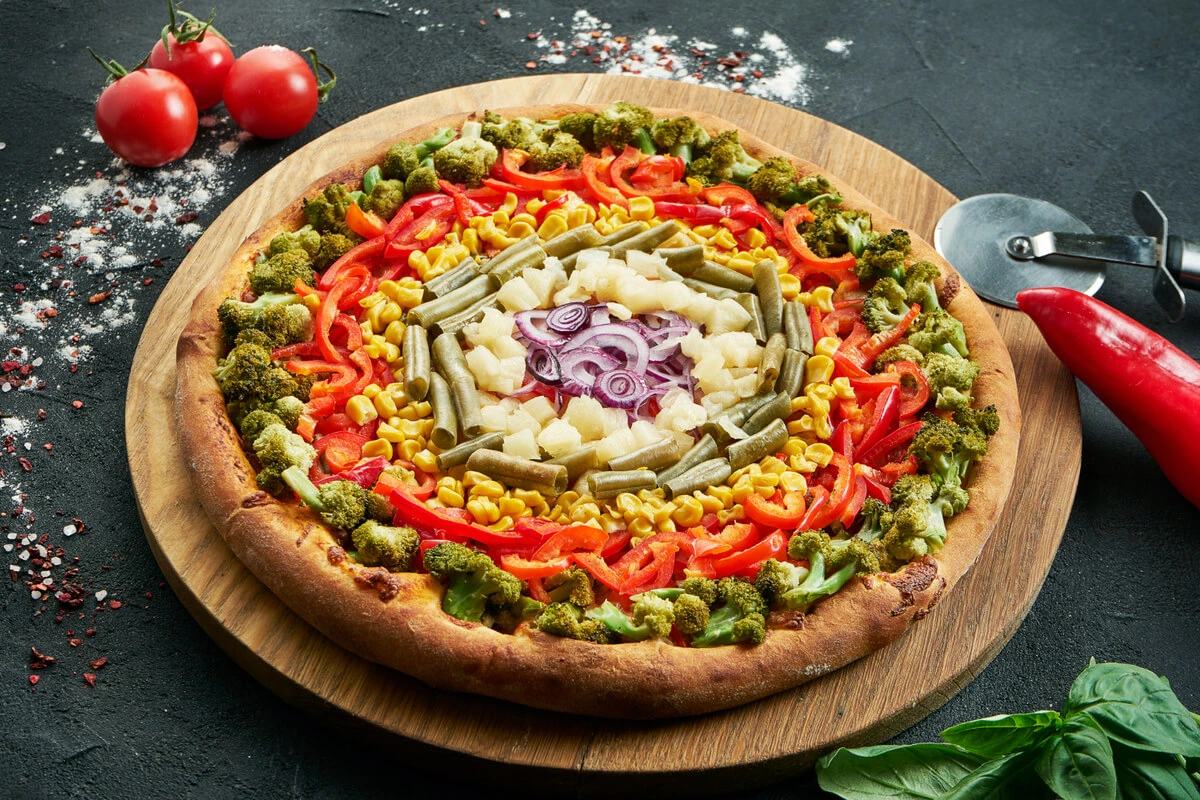Introduction
Pizza is a universal favorite, but the type of crust you choose can significantly impact its nutritional value. While traditional pizza crusts are often made with refined flour, which is high in calories and carbs but low in nutrients, alternative options like cauliflower crust have gained popularity for their health benefits. This shift has sparked an important question: What is the healthiest pizza crust?
A healthy pizza crust should strike a balance between taste and nutrition. It’s typically lower in calories, carbohydrates, and unhealthy fats while being higher in fiber, protein, and essential nutrients. Options like whole wheat, almond flour, and vegetable-based crusts aim to meet these criteria. The debate between cauliflower crust and regular crust often centers on their calorie content, carbohydrate levels, and overall nutritional profile.
This guide will explore various pizza crust options, compare their nutritional benefits, and help you make informed choices to enjoy a healthier slice without compromising flavor. Whether you’re calorie-conscious, looking for a gluten-free option, or simply seeking better ingredients, this article will help you discover the best crust for your dietary goals.

1. Understanding Pizza Crust Nutrition
1.1 What Makes a Pizza Crust Healthy?
A pizza crust is more than just the foundation of your favorite slice—it can significantly affect the overall nutritional value of your meal. A healthy pizza crust should provide a balance of essential nutrients while keeping calories and carbohydrates in check. Key factors to consider include:
- Calories: Opt for crusts with lower calorie counts, especially if you’re managing your weight.
- Carbohydrates: Traditional crusts made from refined flour are high in carbs, which can cause blood sugar spikes. Healthier alternatives often use whole grains or vegetable bases to reduce carb content.
- Fiber: Fiber is crucial for digestive health and can help you feel full longer. Whole wheat and vegetable-based crusts are generally higher in fiber.
- Protein: Protein adds a satiating element to the crust, with options like almond flour offering a higher protein content.
- Ingredients: Minimal and whole-food ingredients, such as whole grains, vegetables, or legumes, are preferred over highly processed ones.
Traditional pizza crusts often rely on refined white flour, which lacks essential nutrients like fiber and protein. Additionally, they may contain additives such as preservatives, sugars, or hydrogenated oils, further reducing their health value.
1.2 The Case for Alternative Pizza Crusts
With growing awareness of healthy eating, alternative pizza crusts have become increasingly popular. Options like cauliflower crust, almond flour crust, and whole wheat crust offer more nutritious choices compared to traditional recipes.
- Cauliflower Crust: Low in calories and carbs, cauliflower crust appeals to those following low-carb or gluten-free diets. It also provides nutrients like vitamin C and antioxidants.
- Almond Flour Crust: This gluten-free option is rich in healthy fats, protein, and fiber, making it a favorite for keto enthusiasts.
- Whole Wheat Crust: Higher in fiber and protein than refined flour, whole wheat crusts are a balanced choice for health-conscious individuals.
Incorporating nutrient-rich ingredients not only enhances the health benefits of the crust but also contributes to flavor and texture. For those who enjoy cooking, creating a healthy pizza crust recipe at home allows for complete control over ingredients and nutrition.
2. Cauliflower Pizza Crust vs. Regular Pizza Crust
2.1 Calories Comparison
When comparing calories in cauliflower pizza crust vs. regular pizza crust, the difference is often a deciding factor for health-conscious individuals. A standard 10-inch cauliflower pizza crust typically contains around 150–200 calories per serving (about one-quarter of the crust). In contrast, a similar serving of traditional pizza crust can range from 250–300 calories, depending on the recipe and preparation method.

For those watching their calorie intake, opting for cauliflower crust can save 100 or more calories per serving, especially when combined with lighter toppings. Store-bought options may vary in caloric content due to added ingredients like cheese or starches, so reading labels is essential for accurate comparisons.
2.2 Carbs and Fiber Breakdown
One of the biggest advantages of cauliflower crust is its significantly lower carbohydrate content. Traditional pizza crust, made with refined white flour, often contains 30–40 grams of carbohydrates per serving. In comparison, cauliflower pizza crust generally contains only 10–15 grams of carbs per serving, making it a popular choice for low-carb or ketogenic diets.
Fiber is another key difference. Regular crusts, especially those made from refined flour, provide little to no dietary fiber. Whole wheat crusts are better, offering 2–4 grams of fiber per serving. Cauliflower crusts, depending on the recipe, can deliver a similar amount of fiber, particularly when made with added flaxseed or almond flour. Higher fiber content contributes to improved digestion, prolonged satiety, and better blood sugar control.
2.3 Overall Nutrition
In terms of broader nutrition facts, cauliflower pizza crust outshines regular crust in several areas:
- Protein: While traditional crusts contain some protein from wheat, cauliflower crusts often include cheese, eggs, or almond flour, boosting protein content to 6–8 grams per serving.
- Fats: Cauliflower crust may have a higher fat content, primarily from healthy fats like cheese or almond flour. Regular crusts, in contrast, are usually low in fat unless enriched with oils.
- Vitamins and Minerals: Cauliflower crust is rich in vitamins C and K, as well as antioxidants. These nutrients are largely absent in regular crusts made from refined flour.
However, not all cauliflower crusts are created equal. Store-bought versions often include starches like tapioca or rice flour, which can increase the carb count and reduce the nutritional advantages. For homemade versions, the balance of ingredients determines whether the crust remains a healthier choice.
To avoid issues like sogginess, you can learn more about how to make cauliflower crust crispy.
Is Cauliflower Crust Genuinely Healthier?
While cauliflower crust is often marketed as the healthier option, its benefits depend on how it’s made. Homemade or minimally processed versions can offer lower calories, carbs, and more nutrients. However, heavily processed cauliflower crusts with added starches may not differ significantly from traditional crusts in terms of calories or carbs.
Choosing the right crust ultimately depends on personal dietary needs. For those seeking low-carb, gluten-free, or vegetable-based options, cauliflower crust can be an excellent choice. However, whole wheat crusts might be better for individuals looking for higher fiber content and fewer processed ingredients.
3. Which Pizza Crust Is the Healthiest?
3.1 Popular Healthy Pizza Crust Options
When it comes to healthy pizza crusts, there are several alternatives to traditional refined flour options, each offering unique benefits. Here are some of the most popular choices:
- Whole Wheat Crust:
Made with whole grain flour, this crust is higher in fiber, vitamins, and minerals than refined flour crusts. It promotes better digestion and helps maintain steady blood sugar levels. Whole wheat crusts are ideal for those seeking a balanced option that retains the traditional pizza flavor. - Almond Flour Crust:
A favorite among gluten-free and keto dieters, almond flour crusts are low in carbohydrates but high in healthy fats and protein. This type of crust is naturally gluten-free and offers a slightly nutty flavor that pairs well with various toppings. - Chickpea Flour Crust:
Rich in protein and fiber, chickpea flour crusts are another gluten-free option. They are lower in calories and carbs compared to traditional crusts and provide a slightly earthy flavor. - Quinoa Crust:
Made from cooked quinoa, this crust is packed with plant-based protein and essential amino acids. Quinoa crusts are a great choice for vegetarians or anyone looking to incorporate more whole foods into their diet.
Each of these alternatives has its unique advantages, making it easier to find a crust that aligns with specific dietary preferences, whether you’re looking for gluten-free, low-carb, or nutrient-dense options.
3.2 Which Pizza Crust Is the Healthiest?
Which pizza crust is the healthiest? The answer depends on your dietary needs and preferences.
- For Low-Carb Diets:
Cauliflower and almond flour crusts stand out for their low carbohydrate content. They’re ideal for those on keto or Atkins-style diets. - For High-Fiber Needs:
Whole wheat and chickpea flour crusts are excellent for boosting fiber intake, supporting digestion, and maintaining blood sugar levels. - For Gluten-Free Diets:
Almond flour, chickpea flour, and quinoa crusts are naturally gluten-free, making them perfect for individuals with celiac disease or gluten sensitivity. - For Overall Nutritional Balance:
Quinoa crust is a versatile option that offers a good mix of protein, fiber, and essential nutrients while being easy to digest.
Ultimately, the healthiest pizza crust is one that aligns with your health goals. If you’re prioritizing weight management, go for low-calorie or low-carb options like cauliflower. For overall wellness, nutrient-dense crusts like whole wheat or quinoa can provide a well-rounded choice.
To learn more about understanding the benefits of whole grains, visit the Whole Grains Council.
4. Is Cauliflower Crust Really Healthier?
4.1 Addressing the Hype
Is cauliflower crust really healthier? This question has become a hot topic among health-conscious pizza lovers. While cauliflower crust is often marketed as a low-carb, low-calorie alternative to traditional pizza crust, the truth depends on how it’s made.
Homemade cauliflower crusts, made with simple ingredients like riced cauliflower, eggs, and cheese, can be significantly healthier than traditional crusts. They typically have fewer carbs, calories, and more nutrients like vitamin C and antioxidants. However, not all cauliflower crusts deliver these benefits, especially store-bought versions.
Pre-packaged cauliflower crusts often include additional ingredients like tapioca starch, rice flour, and added sugars to improve texture and flavor. These ingredients can increase the carb content, sometimes making the crust comparable to regular crusts in terms of calories and carbohydrates. For example, a common store-bought cauliflower crust may have 120–150 calories and 20–25 grams of carbs per serving—only slightly better than traditional crusts made from refined flour.
While cauliflower crust has its advantages, its reputation is often exaggerated by clever marketing. It’s important to differentiate between minimally processed, nutrient-rich options and those that are over-processed.
For tips on identifying hidden ingredients in processed foods, refer to this guide by the FDA.
4.2 Factors to Consider
When choosing cauliflower crust, there are a few factors to keep in mind:
- Hidden Ingredients: Many store-bought options contain added starches, such as tapioca or potato starch, which increase the carbohydrate count and reduce the nutritional advantage. Some may also include sugars or preservatives, which aren’t ideal for a healthy diet.
- Caloric Content: While some cauliflower crusts are lower in calories, others can include cheese or oils that make them comparable in caloric value to regular crusts.
- Serving Size: Pay attention to serving sizes on the packaging. Some brands list nutritional values for half the crust, which can be misleading.
Importance of Reading Labels:
To ensure you’re truly getting a healthier option, always read the ingredient list and nutritional label carefully. Look for products with fewer additives and prioritize those with minimal, whole-food ingredients.
Ultimately, cauliflower crust can be a healthier choice, but only when selected or prepared with care. For the best results, consider making it at home to control the ingredients and maintain its health benefits.
5. DIY Healthy Pizza Crust Recipe
5.1 The Best Homemade Pizza Crust
Making your own pizza crust at home ensures you control the ingredients and maximize its nutritional benefits. Here’s a simple, versatile healthy pizza crust recipe that uses cauliflower as the base.

Ingredients:
- 1 medium-sized cauliflower head (about 3 cups riced)
- 1 large egg
- 1/2 cup grated Parmesan or mozzarella cheese
- 1/2 tsp garlic powder
- 1/2 tsp dried oregano
- 1/4 tsp salt
Instructions:
- Prepare the Cauliflower:
- Preheat your oven to 400°F (200°C).
- Wash and chop the cauliflower into small florets. Pulse in a food processor until it resembles rice.
- Cook the Cauliflower:
- Microwave the riced cauliflower for 4–5 minutes until softened. Let it cool slightly.
- Place the cooked cauliflower in a clean kitchen towel and squeeze out as much water as possible. Removing excess moisture is crucial for a firm crust.
- Mix the Dough:
- In a bowl, combine the cauliflower, egg, cheese, garlic powder, oregano, and salt. Mix well to form a dough-like consistency.
- Shape the Crust:
- Line a baking sheet with parchment paper. Spread the dough into a 10-inch round, about 1/4 inch thick.
- Bake the Crust:
- Bake for 20 minutes or until the edges are golden and the center feels firm.
You can also use this recipe with almond flour or whole wheat flour, adjusting the ingredients slightly for texture. For almond flour, combine 1 1/2 cups almond flour, 1 egg, and 1/4 cup water to create a dough. For whole wheat, use 1 1/2 cups flour, 1 tsp baking powder, 1/2 cup Greek yogurt, and a pinch of salt.
If you’re looking for a plant-based version, try this vegan cauliflower pizza crust recipe.
5.2 Tips for Customizing
Once your crust is ready, it’s time to add toppings and sauces that align with your health goals:
- Healthy Sauces: Opt for homemade tomato sauce with no added sugars, pesto, or even a light olive oil drizzle.
- Nutritious Toppings: Include lean proteins like grilled chicken or turkey, plenty of colorful vegetables like bell peppers, spinach, or zucchini, and sprinkle with fresh herbs for flavor.
- Cheese Alternatives: Use low-fat mozzarella or experiment with plant-based cheese options to reduce fat content.
Portion Control:
To keep your meal balanced, limit toppings that are high in calories, such as processed meats or extra cheese. Stick to moderate portions—aim for one or two slices paired with a side salad for a wholesome, satisfying meal.
Homemade pizza crusts are not only healthier but also allow endless customization to suit your taste and dietary needs.
6. FAQ Section: Common Questions About Pizza Crust Health
6.1 What’s the Healthiest Pizza to Eat?
The healthiest pizza combines a nutrient-rich crust, balanced toppings, and a light sauce. Start with a healthy crust option such as cauliflower, whole wheat, or almond flour to minimize empty calories and maximize nutritional benefits. For the sauce, choose a sugar-free marinara or pesto to avoid hidden sugars and unhealthy fats.
Toppings play a critical role in determining the overall healthiness of the pizza. Lean proteins like grilled chicken or tofu, plenty of vegetables, and a sprinkle of low-fat cheese ensure a well-balanced meal. Avoid processed meats like pepperoni and sausage, as these are high in unhealthy fats and sodium. Portion control is equally important—pair two slices with a side salad to create a satisfying yet calorie-conscious meal.
6.2 What is a Healthy Substitute for Pizza Dough?
If you’re looking for creative pizza crust alternatives, consider sweet potato or zucchini-based crusts.
- Sweet Potato Crust: This crust is rich in complex carbohydrates and vitamins like A and C. Simply mix mashed sweet potato with almond flour and an egg for a nutrient-dense option.
- Zucchini Crust: Grated zucchini combined with egg and cheese creates a low-carb, high-fiber crust that’s perfect for those seeking a lighter option.
These substitutes provide unique flavors and are naturally gluten-free, making them great alternatives for those with dietary restrictions.
6.3 Which Pizza Crust is the Healthiest to Buy?
When buying pizza crust, look for options with minimal ingredients and no added sugars or starches. Check the label for whole food ingredients such as cauliflower, almond flour, or whole grains.
Brands offering whole wheat or cauliflower crusts with fewer additives are often the best choices. Pay attention to serving sizes and nutritional information, prioritizing crusts that are low in calories and high in fiber or protein. Avoid products with long ingredient lists, as these often contain unnecessary preservatives and fillers.
Conclusion
When it comes to answering the question, What is the healthiest pizza crust?, the answer lies in your personal nutritional goals and preferences. From low-carb cauliflower crusts to fiber-rich whole wheat options, and protein-packed almond or quinoa crusts, each alternative offers unique benefits. The key is to choose a crust that aligns with your dietary needs, whether it’s reducing calories, increasing protein, or finding a gluten-free option.
Beyond the crust, the overall healthiness of your pizza also depends on the toppings and sauces you select. Opting for lean proteins, plenty of vegetables, and low-fat or plant-based cheeses can elevate the nutritional value of your meal. Portion control and mindful ingredient choices play a significant role as well.
For those who enjoy cooking, experimenting with homemade crusts is a great way to ensure quality ingredients and customize the flavor to your liking. Whether you use cauliflower, almond flour, or even zucchini, making your pizza crust at home allows you to create a dish that’s both healthy and delicious.
Pizza doesn’t have to be an indulgence. With the right crust and thoughtful toppings, it can be a balanced, nutritious meal that satisfies both your cravings and your health goals.

